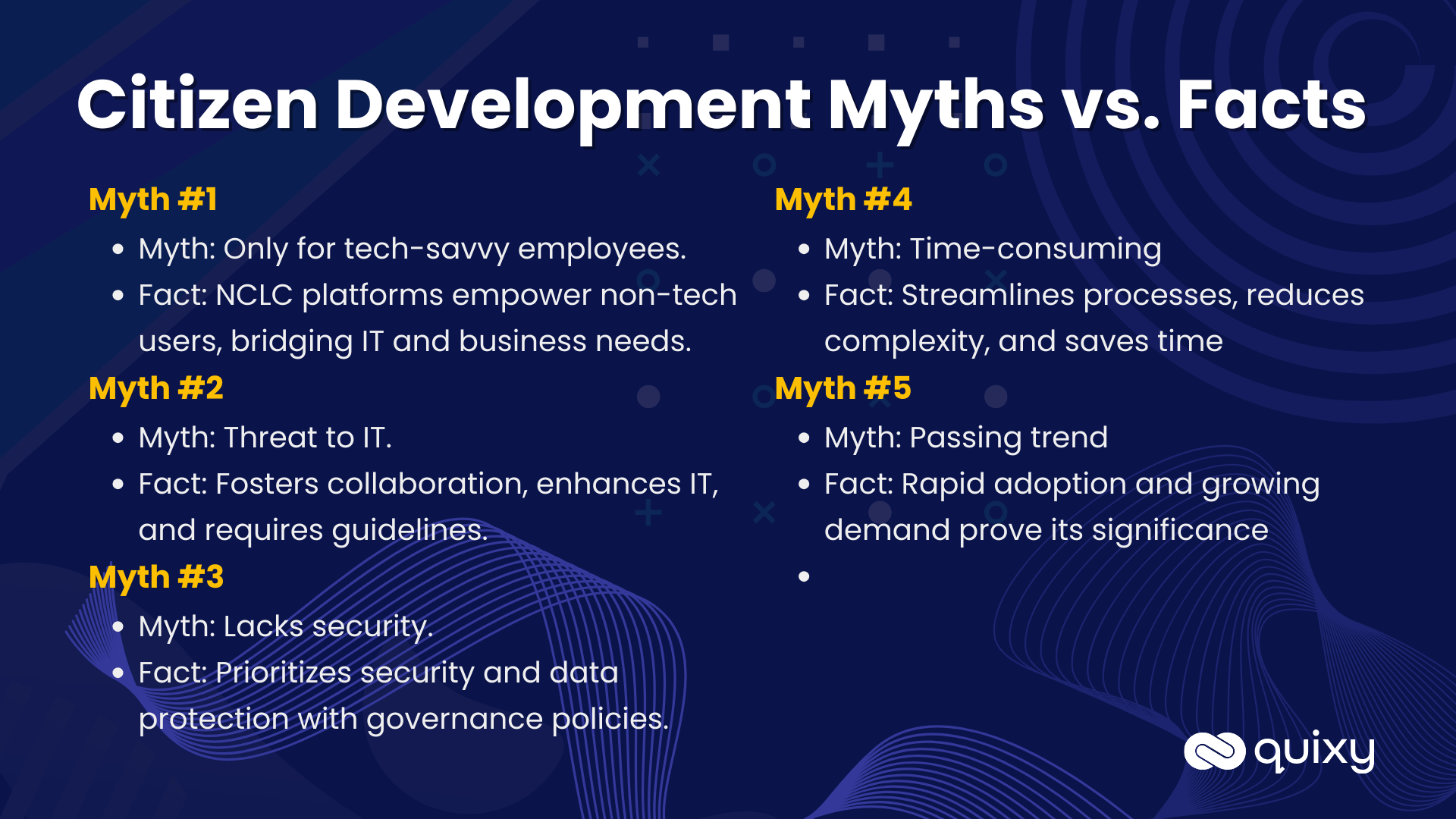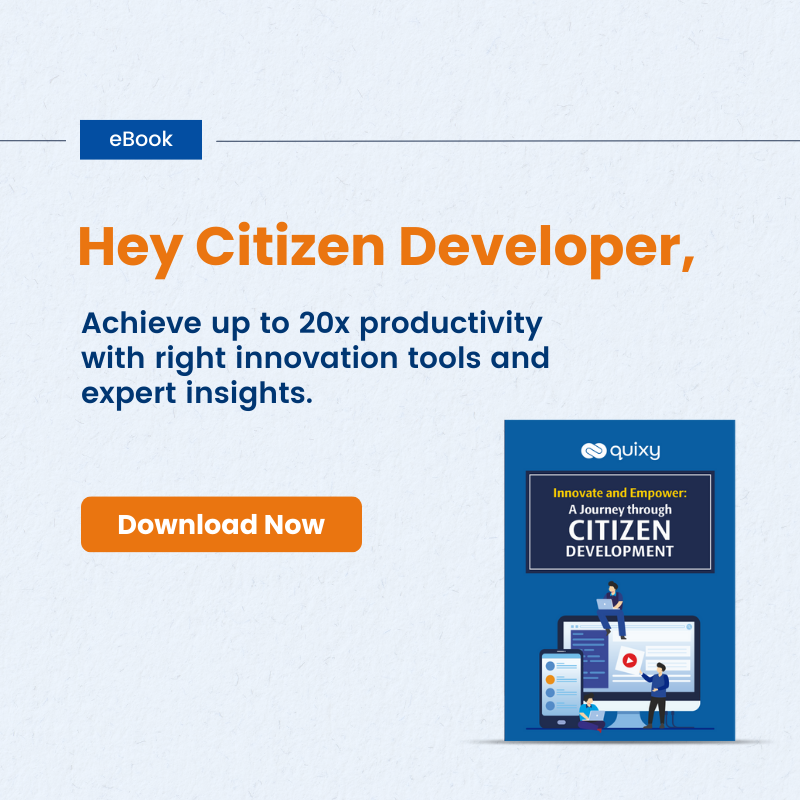07 Nov

“Toyota Motor North America turns employee ideas into apps with Microsoft Power Platform”
reads the headline of a report from the official Microsoft website, which provides information on how Toyota employees have used the Microsoft Power apps to create more than 400 applications that help the company, from product quality control to COVID-19 screening. To control this development, Toyota Motor North America (TMNA) has also created a center of excellence that trains and supports employee efforts. This is an excellent example of “Citizen Development” deployed at a large scale. Let’s dive into the fascinating world of digital empowerment, exploring the myths vs. facts of citizen development.
What is Citizen Development? – An Introduction
Citizen development in IT is a growing trend that empowers business users, especially non-IT employees, without the need for extensive coding knowledge or IT support to build and scale functional business applications that they need to automate and streamline their business processes. This is typically achieved through the use of No Code Low Code (NCLC) platforms like Quixy.
While this approach has been gaining a lot of traction lately among corporates, it comes with its share of questions, misconceptions, and myths that hinder its widespread adoption. It is crucial to debunk these myths to embrace the benefits that citizen development has to offer fully, and this blog post is an approach to do the same.
Myths Vs. Facts of Citizen Development

Myth #1: – Citizen development is only for Tech-savvy employees
It is a known fact that developing new applications requires a thorough understanding of coding skills. While it is true in a common scenario, NCLC platforms change this completely. These NCLC platforms provide drag-and-drop features which makes it possible for employees with varying technical backgrounds to develop applications according to their process needs.
These platforms are so user-friendly that even employees with technical expertise can leverage their knowledge to create more sophisticated solutions. As a matter of fact, many successful citizen developers possess a blend of technical and business acumen, bridging the gap between IT and business needs.
Also Read: 7 Steps to Become a Citizen Developer
Myth #2:- Citizen development is a threat to IT Departments.
Citizen development decentralizes the application development process. Hence the companies the afraid that this might lead to chaos in the IT or it might replace engineers or IT departments altogether. Another similar misconception is that since various employees might create applications without any oversight, it might lead to a situation of confusion.
Demystifying the first part, Citizen development is not about replacing IT departments; rather, it’s all about collaboration. Citizen development might be a way to offload simple tasks from seasoned IT professionals thus allowing them to focus on more important and complex projects. A solution to the second problem is to establish proper guidelines that could be adhered to by these developers. This can lead to the development of a symbiotic relationship, where these citizen developers can gain access to IT expertise while the IT teams benefit from the insights and problem-solving abilities of citizen developers.
Myth #3:- Citizen Development lacks security and Governance.
Professionals or companies have zero tolerance where customer data is involved and they take absolutely no risk when it comes to security and data protection. And since Citizen Development is about business users developing applications using NCLC platforms, it’s a common belief that the data might not be secure due to a lack of required technical expertise.
The reality is, however, completely different. These NCLC platforms prioritize security and compliance above everything else, incorporating robust measures to protect data. NCLC platforms like Quixy provide a secure platform for application development which ensures that the applications developed by these citizen developers are inherently secure. Additionally, organizations can establish governance policies to make sure that the citizen development initiatives align with security and compliance. These policies provide a framework for managing access, data protection, and application deployment.
Myth #4: Citizen Development is time-consuming and inefficient.
This misconception is deeply rooted in the fact that development needs complex coding and lengthy development cycles. However, the reality is very different. Citizen development platforms are designed to mitigate exactly this problem. To streamline processes, enabling rapid prototyping cycles and easy deployment. Features like Visual Interfaces, Drag-and-drop functionality, and pre-built components make NCLC platforms like Quixy a perfect solution for the requirement of complex coding and technical expertise for application development. It helps citizen developers create applications with minimal coding, significantly reducing development time.
Also Read: How to Implement and Govern Citizen Development
Several examples across various industries provide evidence of the time and cost savings through citizen development initiatives. Below is one such example.
Case 1: Equinor, a global leader in the energy industry, partnered with HCL tech to enhance its Power platform adoption and citizen developer platform. The program aimed to identify key user personas, provide training and certification workshops for Power Apps, Power Automate, Power BI, and Dataverse, and encourage employees to maximize the platform’s potential. As a result, Power Apps development doubled, with over 270 citizen developers certified in the first year. Power Platform usage increased, and employee enthusiasm grew, making Equinor a flagship adopter in the European market. The program’s impact included increased adoption, upskilling the organization, and empowering citizen developers for enhanced operational processes.
Case 2: Another example is the energy giant Shell, which implemented a citizen development program to address the challenge of managing a large volume of safety inspections. Using an NCLC platform, citizen developers built an application to streamline the inspection process, which reduces the inspection time by almost half.

Myth #5: Citizen development is a passing trend.
COVID-19 has created an environment of rapid digitalization and made remote work a common thing. This has triggered automation and demand for digital solutions to enable it So the notion that Citizen development is a fleeting trend is a misconception that fails to recognize the impact it is having on the landscape of application development. It is not just a fad but a movement that is gaining momentum across various industries.
Below are some facts to prove the above point:
- The adoption of low-code and no-code platforms, which serve as the foundation for citizen development, is rapidly accelerating. According to a report by Mordor Intelligence, The Low Code Development Platform Market size is expected to grow from USD 12.74 billion in the current year. It is expected to reach USD 41.30 billion by the next five years, registering a CAGR of 26.52% during the forecast period.
- Furthermore, the demand for citizen developers is growing exponentially. A study by Forrester predicts that by 2024, there will be a shortage of 500,000 professional developers, while the demand for citizen developers will reach 45 million. This skills gap highlights the crucial role citizen developers will play in bridging the gap between the demand for applications and the availability of traditional developers.
Also Read: 5 Reasons to Encourage Citizen Development at Work
The Future of Citizen Developers – A Conclusion
No-Code Low-Code (NCLC ) platforms lead the path towards innovation, redefining the way organizations adapt to the changes in the way applications are developed. These platforms empower business users, also known as Citizen developers, to create powerful solutions without requiring extensive technical and coding experience. However, like any other ground-breaking technology, Citizen Developers has also encountered its share of misconceptions and skepticism that has slowed its adoption. This blog not only aims to counter these myths and unveil the potential of these platforms but also encourages organizations to embrace citizen development.
Frequently Asked Questions(FAQs)
Q. How can companies balance citizen development with IT governance?
Companies can strike this balance by establishing clear guidelines and policies for citizen developers. IT teams should provide oversight and support, ensuring that citizen-developed solutions align with security, compliance, and integration requirements while allowing business units to innovate and solve their specific needs.
Q. What are benefits of embracing citizen development within a business?
Embracing citizen development empowers non-technical users to create solutions tailored to their unique needs. This can lead to faster innovation, increased agility, and reduced IT backlog. It fosters a culture of problem-solving and collaboration, enhancing overall productivity and efficiency.
Q. Are citizen developers IT professionals or non-technical users?
Citizen developers are typically non-technical users within an organization. They may come from various departments, possessing domain expertise rather than formal IT training. They use low-code or no-code platforms to build applications and automate processes without in-depth coding knowledge.
Q. Is citizen development secure & compliant with data regulations?
While citizen development can be secure and compliant, it requires careful management. Organizations should implement security controls, monitor access, and ensure data protection and compliance with regulations like GDPR or HIPAA. Balancing user empowerment with IT oversight is essential for maintaining security and compliance.
Q. How citizen development impact IT departments & their workload?
Citizen development can reduce the IT workload by enabling business units to address their own needs. IT departments can focus on mission-critical tasks, infrastructure management, and providing support and guidance to citizen developers. This can lead to a more efficient allocation of IT resources.
Q. What are real-world examples of citizen development in organizations?
Examples of successful citizen development include automating HR processes, creating custom CRM solutions, and developing department-specific reporting tools. These initiatives streamline operations, improve user experiences, and drive innovation. Notable organizations, such as Microsoft and Intuit, have harnessed the power of citizen development to enhance their internal processes and customer-facing solutions.
Subscribe
Login
Please login to comment
0 Comments














